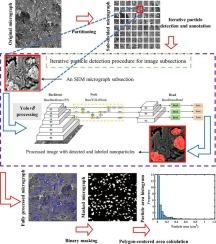A visual-probabilistic framework for analyzing nanoparticle size distribution characteristics in polymer nanocomposites containing two reinforcements
IF 4.6
2区 工程技术
Q2 ENGINEERING, CHEMICAL
引用次数: 0
Abstract
The dispersion quality of rigid nano-inclusions significantly impacts polymer nanocomposite properties, necessitating a rigorous quantitative post-characterization of particle size distribution (PSD). This study combines probabilistic analysis with deep learning-based particle recognition for precise PSD measurement and dispersion characterization. A ternary nanocomposite of polyoxymethylene (POM), carbon black (CB), and nanoprecipitated calcium carbonate (NCC) was analyzed. Z-score filtering removed outliers, enabling accurate PSD histograms. Goodness-of-fit tests—Chi-Square (CS), Kolmogorov-Smirnov (KS), and Anderson-Darling (AD)—identified the Gamma distribution as the optimal PSD model. Gamma probability distribution analysis revealed that 3 wt% NCC reduced skewness and kurtosis by 18.23 % and 33.13 %, respectively, compared to POM/CB, thereby indicating improved PSD uniformity. Proportional size distribution (PRSD) analysis compared percentiles and with a benchmark, alongside undersized () and oversized () particle proportions. Introducing 1.5 wt% NCC reduced and by 34.21 % and 60.17 %, increased by 42.17 %, and decreased by 90.54 %, indicating finer, more consistent PSD.

含两种增强剂的聚合物纳米复合材料中纳米颗粒尺寸分布特征的视觉概率分析框架
刚性纳米包裹体的分散质量显著影响聚合物纳米复合材料的性能,因此需要对粒径分布(PSD)进行严格的定量后表征。该研究将概率分析与基于深度学习的粒子识别相结合,用于精确的PSD测量和色散表征。研究了聚甲醛(POM)、炭黑(CB)和纳米沉淀碳酸钙(NCC)的三元复合材料。Z-score过滤去除异常值,实现准确的PSD直方图。拟合优度检验-卡方检验(CS), Kolmogorov-Smirnov检验(KS)和Anderson-Darling检验(AD) -确定Gamma分布为最优PSD模型。伽马概率分布分析显示,与POM/CB相比,3wt %的NCC分别降低了18.23%和33.13%的偏度和峰度,从而改善了PSD均匀性。比例尺寸分布(PRSD)分析比较了P10,A和P90,A与基准的百分位数,以及尺寸不足(PUPP)和尺寸过大(POPP)的颗粒比例。加入1.5 wt%的NCC后,P10、A和P90分别降低34.21%和60.17%,PUPP提高42.17%,POPP降低90.54%,PSD更细、更一致。
本文章由计算机程序翻译,如有差异,请以英文原文为准。
求助全文
约1分钟内获得全文
求助全文
来源期刊

Powder Technology
工程技术-工程:化工
CiteScore
9.90
自引率
15.40%
发文量
1047
审稿时长
46 days
期刊介绍:
Powder Technology is an International Journal on the Science and Technology of Wet and Dry Particulate Systems. Powder Technology publishes papers on all aspects of the formation of particles and their characterisation and on the study of systems containing particulate solids. No limitation is imposed on the size of the particles, which may range from nanometre scale, as in pigments or aerosols, to that of mined or quarried materials. The following list of topics is not intended to be comprehensive, but rather to indicate typical subjects which fall within the scope of the journal's interests:
Formation and synthesis of particles by precipitation and other methods.
Modification of particles by agglomeration, coating, comminution and attrition.
Characterisation of the size, shape, surface area, pore structure and strength of particles and agglomerates (including the origins and effects of inter particle forces).
Packing, failure, flow and permeability of assemblies of particles.
Particle-particle interactions and suspension rheology.
Handling and processing operations such as slurry flow, fluidization, pneumatic conveying.
Interactions between particles and their environment, including delivery of particulate products to the body.
Applications of particle technology in production of pharmaceuticals, chemicals, foods, pigments, structural, and functional materials and in environmental and energy related matters.
For materials-oriented contributions we are looking for articles revealing the effect of particle/powder characteristics (size, morphology and composition, in that order) on material performance or functionality and, ideally, comparison to any industrial standard.
 求助内容:
求助内容: 应助结果提醒方式:
应助结果提醒方式:


